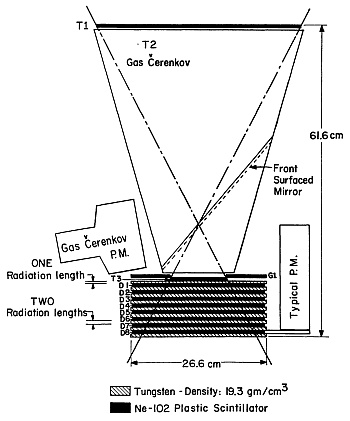Purpose of the flight and payload description
LEE (Low Energy Electron) was an instrument created to measure the energy spectrum of cosmic ray electrons. It was developed in the late 1960's decade at the University of Chicago. After the first series of flights from South Dakota in 1967, regular balloon flights have been made from Northern Canada every year from 1968 to 1975 and approximately bi-annually until 1979. Then, the experiment was transfered to the University of Delaware, wich now operates it. The observations from LEE provided the scientific community with one of the more precise measurements of the electron spectrum over a period of time of more than 50 years.
In the image at left can be seen an scheme of the instrument (click to enlarge). It consisted of two major components: a four-element particle telescope and an absorption spectrometer. The telescope included two plastic scintillation counters, T1 and T3, that defined a 30° half-angle cone, providing a geometry factor of 41 cm² steradians. The third component, T2, was a gas Cerenkov counter filled with Freon 12 at atmospheric pressure, which set a velocity threshold corresponding to ? = E/mc² = 21, making the system insensitive to nuclear cosmic rays below 20 GeV per nucleon. The Cerenkov counter employed a plane mirror to reflect light produced by downward-moving particles into a 5-inch photomultiplier, while light from upward-moving particles was absorbed. The final element, the guard counter (G), was an annular ring coplanar with T3, designed to detect unwanted particles at the same depth.
The spectrometer section comprised nine tungsten plates interleaved with eight plastic scintillation counters (D1 through D8). This arrangement formed a 15 radiation-length-deep absorber, capable of producing and measuring cascade showers from incoming electrons. The tungsten plates varied in thickness, with the first being approximately one radiation length and the others around two radiation lengths. Electron-photon cascades produced in the tungsten were measured at various depths, yielding shower profiles indicative of the primary electron's energy.
The instrument incorporated amplifiers with high dynamic range and log-linear characteristics, paired with 256-channel pulse-height analyzers for each D-counter. A fourfold coincidence among T1, T2, T3, and D4 was required to initiate measurements, effectively excluding low-energy electrons below 500 MeV. Data acquisition was supported by an on-board magnetic tape recorder and a telemetry system. The system also included a recirculating memory for simultaneous acquisition and processing of multiple events. To monitor performance, housekeeping data, including time, pressure, and temperature, were recorded periodically.
The entire detector was housed in a pressure-tight shell to maintain one atmosphere during flight. With a total weight of 600 pounds, including batteries, and a power consumption of 30 watts, the system was optimized for operation in the upper atmosphere.
Details of the balloon flight
Balloon launched on: 11/20/1967
Launch site: Rapid City, South Dakota, US
Balloon launched by: ?
Balloon manufacturer/size/composition: Zero Pressure Balloon
End of flight (L for landing time, W for last contact, otherwise termination time): 11/20/1967
External references
- The Energy Spectrum of Primary Cosmic Ray Electrons from 2 GeV to 200 GeV Astrophysics and Space Science, Volume 14, Issue 2, pp.301-313
7028If you consider this website interesting or useful, you can help me to keep it up and running with a small donation to cover the operational costs. Just the equivalent of the price of a cup of coffee helps a lot.


